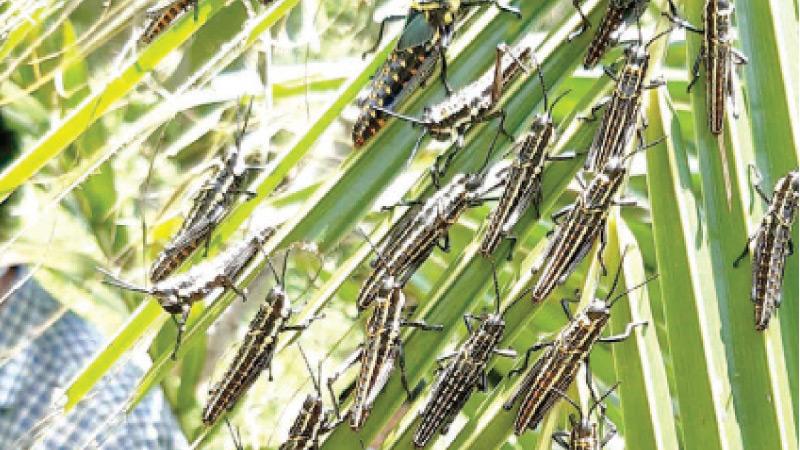
The locust infestation which threatened vegetation and farming lands in two districts is largely under control and the Department of Agriculture is working with farmers to bring the infestation to a manageable level, Dr. Ajantha de Silva of the Ministry of Agriculture said.
Farmers were advised to smoke or set fire to locusts in small numbers. Dr. Silva said the Department aided by spraying pesticides to larger nests.
The Coconut Cultivation Board (CCB) is working together with the Department of Agriculture to eliminate the yellow-spotted locust threat in Kegalle and Kurunegala.
 Jayantha Weerasooriya, a father of five from Katupitiya in Kurunegala, who owns a farm, said the locust threat has worsened over the past week.
Jayantha Weerasooriya, a father of five from Katupitiya in Kurunegala, who owns a farm, said the locust threat has worsened over the past week.
“These insects eat all the leaves of coconut trees and leave only the iratu kuru,” Weerasooriya said.
One of the coconut planters from his area who approached the CCB for help was told that pesticides will be sprayed on his affected trees free of charge to manage the spread of the infestation.
“These farmers don’t know what to do about this anymore,” he added.
The National Organiser of the ‘All Ceylon Peasants Federation’, Namal Karunaratne, said some farmers have given up all hope and if the desert locust which is causing chaos in India spreads to Sri Lanka, the situation for farmers will be even worse.
Indian media reported that farmers and authorities are using drones, fire trucks, loud music and banging utensils to chase away the swarms.
Desert locusts spread to India from Pakistan where authorities declared a nationwide emergency in February. Now China has vowed to deploy 100,000 ducks in Pakistan to manage the spread.
“We will have to get ready for the desert locust plague. For that we have to first get rid of the locusts that are already spreading here,” Karunaratne said.
Duty Meteorologist at the Department of Meteorology Dharshana Chamil said the wind, that aids the spread of the locusts from country to country, blows to the island from the South Western area. This minimises the possibility of a possible desert locust spread to Sri Lanka.
“We usually receive wind through India during December and January. This is from the South Western area,” Chamil said. He said this, however, could change temporarily due to changes in the climatic patterns.
Addressing the issue of the yellow-spotted locust that is harming coconut plantations in Kurunegala and Kegalle, General Manager of the CCB, M. J. S. Ravisinghe said they are trying to terminate locusts while they are in the early stage of their lifecycle.
“During this stage the locusts lay eggs on the ground and stay closer to the ground too. That is why it is not that hard for us to terminate them during this time,” he added.
Officials of the CCB are helping local planters by spraying pesticides on the locusts.
Ravisinghe said when the locusts’ starts to fly high (during the latter part of their lifecycle) it will be difficult to kill them. “This is because we can’t climb all coconut trees to spray pesticides,” he added.
The Department of Agriculture called upon farmers to contact them with information of locust sightings in their areas on the emergency hotline 1920.
